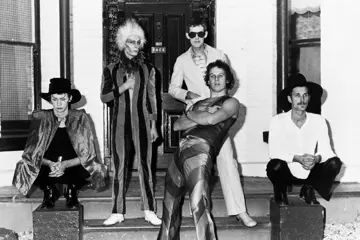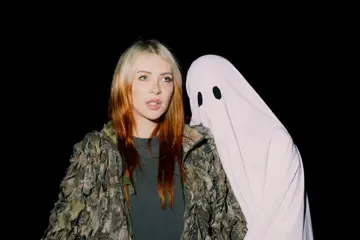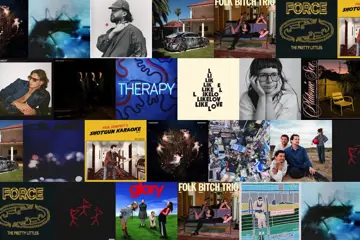A CURE FOR WELLNESS

Who knew Gore Verbinski had so much clout? Apparently having made three Pirates Of The Caribbean movies brings you a lot of Hollywood sway, as the director bounces back from his disastrous Lone Ranger by somehow marshalling a $40mil budget for a 146-minute B-movie. A Cure For Wellness is a wacky, wonky, psychological thriller best described as cod-Polanski, in which a financial trader ends up trapped, on “enforced vacation”, in an upscale health-spa built inside a gothic castle high in the Swiss Alps.
Dane DeHaan plays its lead as a smug dickwad, the kind of cocky cad who needs to be broken down, beaten up, and humiliated before he can claw his way towards salvation. He’s, essentially, a man trapped between undesirable worlds, bouncing from the horrors of New World America (corporate, money-driven, work-obsessed) to the horrors of Old World Europe (eugenics, inbreeding, decadent royalty). The film turns the cult of good health into a death cult: the wealthy, white-clad, never-leaving patients of the “wellness centre” the lobotomised Stepford Wives of health-industry narcissism; banal rituals like massages, aquarobics, and steam baths made sinister.
Justin Haythe’s script employs the standard gaslighting of the paranoia thriller, DeHaan being told he’s “not a well man” so many times the idea takes hold. There’s more familiar horror tropes, too: menacing local yokels, disturbing dreams, and so many eels you don’t know what to do with them. The film’s most amazing sequence is, essentially, a dental anxiety nightmare, in which DeHaan is strapped into a reclining chair, given no anaesthetic, whilst a pitiless German takes a drill to his teeth. There’s other moments where Verbinski shows unexpected restraint, and a real command of mood: the rhythmic clunk of a toilet’s flush button mined for sinister unease, the shadowy hallways and Gothic catacombs inviting his camera to linger.
Don't miss a beat with our FREE daily newsletter
But, what seems, for much of its run, like an unexpected exercise in old-fashioned paranoia blows out, grows mutant, loses its way. At the end of its third act, the film seemingly has come to a neat, grimly ironic finish; circling back to its start, DeHaan trapped in a deathly cycle. Only, A Cure For Wellness then, suddenly, abruptly shears off, staging a bonkers, extended, wildly-silly extra frame. Where there’s immortality, incest, reptilian-faced villains, fistfights in the face of deadly fires, a damsel in distress, and a crazily-coincidental culmination that — at the end of two-and-a-half-hours — ultimately feels like one moment of ridiculousness too many.
LOVING

Loving is Jeff Nichols’ portrait of the 1958 marriage, between Richard and Mildred Loving, that became a rallying point for repudiating archaic mixed-race marriage laws in the desegregated American South. That sounds plenty Oscarbaity, for sure; and Ruth Negga, playing wife opposite Joel Edgerton’s husband, earned a Best Actress nomination for her sterling work, here. But the kind of melodramatic grandeur shown in Amma Assante’s concurrent mixed-race history-lesson, A United Kingdom, gets no play. Instead, Loving is a humble film about humble people; in which humanity and dignity win out, both cinematically and historically.
Nichols — last seen getting his retro-Spielberg on with the sci-fi road-movie opus Midnight Special — has little interest in presenting his film as a sober history-lesson, largely eschewing the pageantry and gravity of the courtroom movie. Instead, his mise-en-scène is rural realism: the film thick with the sounds of birds and crickets, casting its camera on dirt roads and dirty men; its ‘heroes’ people who want to be left alone, to make a family and a life. When the epochal edict is handed down from on high, we’re not in the supreme court, bowing down before the seat of power, but in throes to a parade of charmingly-banal quotidian images: lawns being mown, kids playing on swings, the routine of dinner and bedtime preserved. It’s a sweet approach that, aesthetically, feels closer to downbeat than inspirational. But it also feels more true, real, raw; history not presented as glib lesson, but as lives lived.
THE SALESMAN

Where entire genres — if not Hollywood itself — revolve around tales of personal vengeance, Asghar Farhadi’s masterful cinema has been about systems of social justice: the way fate can be left in the hands of peers (About Elly), grieving relatives (Beautiful City), or judges (A Separation); the way that notions of right and wrong are rarely invited into his complex moral tangles. The Salesman — which just won the Best Foreign Picture Oscar — is his first film to tackle the idea of justice as individual crusade, even if Beautiful City was built on notions of retribution.
Here, Shahab Hosseini and long-time Farhadi collaborateur Taraneh Alidoosti play a husband-and-wife pair who’re acting in a production of Death Of A Salesman. When the wife is assaulted in their new apartment — something that, as is Farhadi’s way, happens off-screen, and creates a central sense of mystery where the truth is slippery — Hosseini becomes consumed with the incident; befitting a culture in which shame is intimately connected with sex, social mores, and legal workings. He attempts to track down the perpetrator, but there’s no virtue in his mounting obsession, no redressing of his patriarchal humiliation, not pay-off where he gets to square some karmic ledger.
The Salesman is, in this way, classic Farhadi. It’s a melodrama and a mystery that’s depicted with stark vérité, the theatrical dressed in realist threads. There’s domestic states in disarray, broken glass, class conflict, the discrepancy between male and female rights in Iranian society. In the grand realm of cinema, it’s a work above and beyond most. Yet, when judged against Farhadi’s filmography, it fares worse; this Farhadi’s most heavy-handed, symbolically-laden film.
THE EAGLE HUNTRESS

The Eagle Huntress is a documentary for those who want their portraits of distant cultures to be lightly ‘exotic’ and ultimately unthreatening. High in the stunning, wide-screen worthy Altai mountains of Mongolia, itinerate locals have — as Daisy Ridley’s pleasingly-posh narration explains for the G-rated crowd — been using eagles to hunt for game for millennia. The film picks up with a 13-year-old girl, who’s learning the ropes of a traditionally-male realm; her mastery of the ancient craft a rebellion against entrenched patriarchy.
First-time filmmaker Otto Bell was an Englishman working in advertising when he saw a picture of his subject, Aisholpan Nurgaiv, standing aloft a snowy mountain, golden eagle grabbing her fist. Befitting his background, he saw something he could sell, and The Eagle Huntress is packaged with a Disneyist, ‘inspirational’ glow that feels cynical. Here, the editing is reality-TV slick, Jeff Peters’ score overt and forceful, the message simplified. By the time the film closes with a power-ballad where Sia wails “you can do anything!”, the reductionism seems flagrant; a culture, a tradition, and a life boiled down to the cinematic equivalent of a Girl Power t-shirt.
DAVID STRATTON: A CINEMATIC LIFE

His name may be in the title, but anyone expecting a documentary digging deep into the life of the dean of Australian cinema will find A Cinematic Life incomplete, at best. Whilst there’s talk of Stratton’s childhood, his distant relationship with his parents, his immigration to Australia, and, of course, his decades-long televisual stoush with Margaret Pomeranz, there’s little sense of who Stratton is beyond guy-who’s-seen-a-lot-of-movies. Were you to go by this film, you’d suspect that he’d never actually had sex before, as there’s not a single mention of wife or lover. Compared to another recent work of film-critic documentarisin’, Steve James’ profound Life Itself, Sally Aitken’s documentary feels all too polite, mannered, English; kept at a tasteful remove so as not to upset its reluctant subject.
Given there’s so little that’s personal, here, the film becomes something other than a study of its titular subject. Instead, it shifts the theme: becoming not about David Stratton, but about Australian cinema. So, we get mini cine-essays on Wake In Fright, Picnic At Hanging Rock, My Brilliant Career, Head On, Strictly Ballroom, Muriel’s Wedding, The Castle, Shine, Romper Stomper, Samson & Delilah, etc, becoming a picture of Stratton at work; not a portrait of a critic, but a work of criticism. Whilst the idea of Stratton and local films as being indivisible works thematically, the film sits together awkwardly, feeling more far televisual than cinematic.
THE DEATH AND LIFE OF OTTO BLOOM

Cinema is the artform of time, and Kris Jones’ debut film is wholly concerned with it. Here, like some less-utterly-awful Benjamin Button, its titular hero (Xavier Samuel) experiences time in reverse; moving through it in the opposite direction, your future his past, your memories his yet-to-come. It’s a high-concept pitch that doesn’t quite stick, though it’s not for want of trying. Shot in Melbourne (scenic suburban Ivanhoe in the house!), Jones stages The Death And Life Of Otto Bloom as a mockumentary, employing standby docu-tropes — talking-heads, mock archive footage and newspaper clippings, animated planes flying across maps — to convey his wildly-ambitious premise on a home-grown budget.
In searching for an emotional core, the film is staged as a tragic romance; Samuel and his paramour (played by Matilda Brown in her younger years, Rachel Ward in her older ones) two people heading in different directions; temporality a prison that their affection can’t cross. If, as Nathan Heller put it, every true love story is a story of bad timing, here it’s not just timing, but time itself, that undoes seemingly-fated romance. It’s a noble attempt to make a head-scratchin’ film more human, but a cringingly-misjudged third act reversal suddenly scuttles its earned emotion: this yet another film that poses true devotion — via a series of unintentionally-hilarious, through-the-years photobombs — as a form of glorified stalking.















